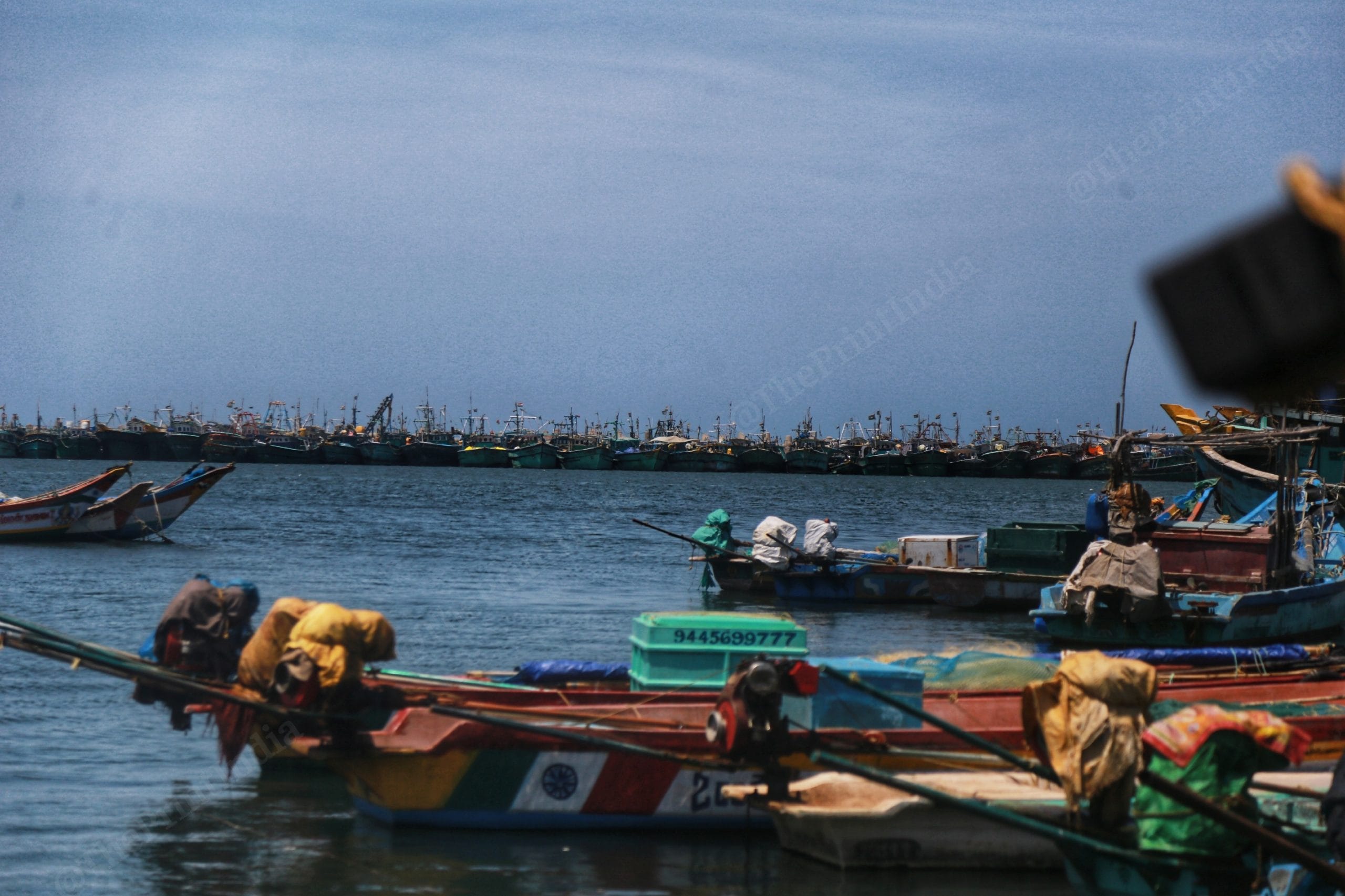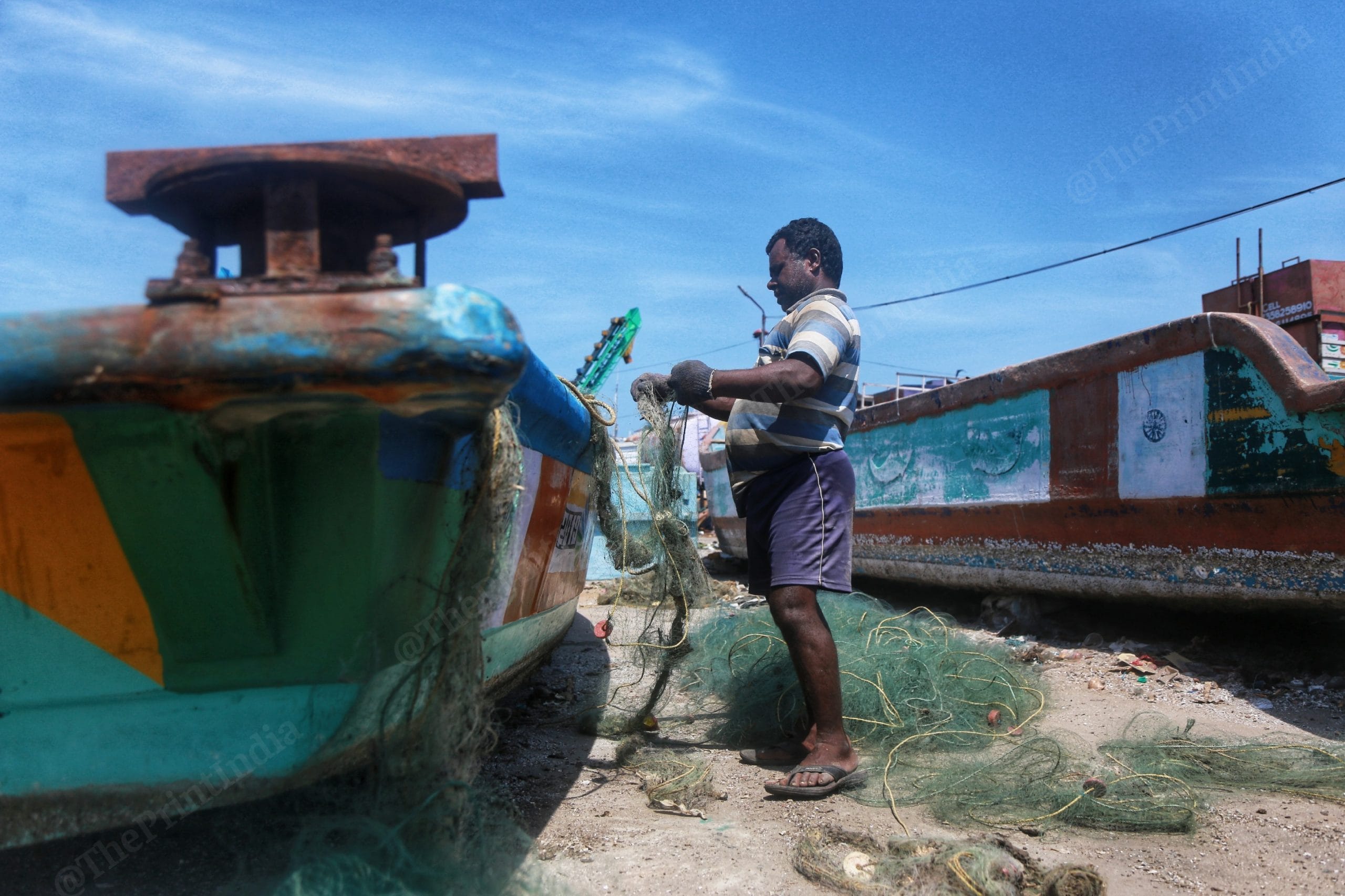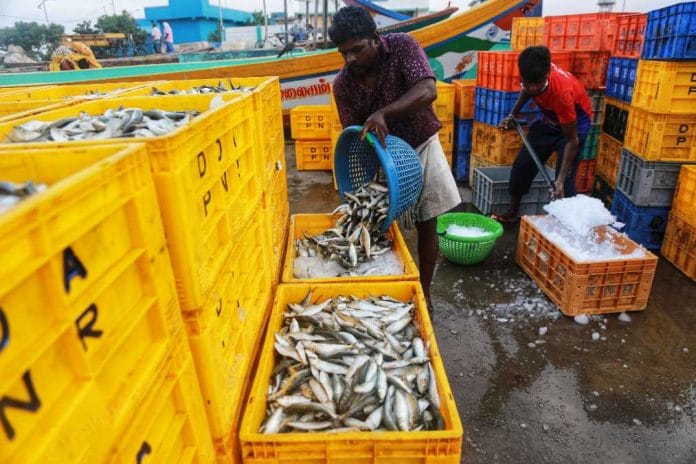Chennai: The period between mid-April and mid-June is usually not a good time for fishermen as far as business is concerned. It’s the breeding season, when the coastal states of India, aiming to conserve marine resources, ban trawlers in the sea and allow only small fibre boats to fish.
This year, the period coincided with the lockdown, leaving fishermen with little to no income for two months.
Chennai’s Kasimedu Fishing Harbour in Royapuram area, among the largest harbours in Tamil Nadu, was a witness to this misery.
But with Unlock 1 coming into force from 1 June, the area around the harbour, also known as the Royapuram fishing harbour, is now buzzing again. Due to the lockdown, the ban period was cut short this year and ended 31 May, according to a 28 May order from the state animal husbandry, dairying and fisheries department, accessed by ThePrint.
Big mechanised boats are now allowed to venture into the sea, and they are bringing back tonnes of fish. Selling them, though, is still a problem as the Kasimedu fish market in Chennai remains shut.
In all likelihood, it will open on 15 June, G.S. Sameeran, managing director of the state government’s Tamil Nadu Fisheries Development Corporation Limited, told ThePrint earlier this week.
Anticipating a large number of buyers in the fish markets, the fisheries department stipulated in the 28 May order that “large-scale auctioning of fishes in the premises of fishing harbours and fish landing centres should be avoided” in order to observe social distancing.
Separate places have instead been earmarked for a limited number of buyers, with fixed hours for retail sales. Fish processing factories have been allowed to function with the required number of staff.
The document also said the district administration should permit movement of labourers to work in “fish processing industries with social distance to avoid accumulation of stock in factories”. Further transport of fish to other states and districts was allowed with appropriate permits.

Tamil Nadu’s over 1,000-km coastline supports the livelihood of more than 10 lakh marine fishers through 5,893 mechanised and 38,779 traditional fishing craft. India is the second largest fish producer in the world and ranks second in inland fish production too. Fisheries contribute 1 per cent of the country’s GDP.
While the lockdown exemptions announced by the government after the end of the first phase (from 15 April) covered the fisheries sector, the absence of key inputs such as ice and labourers kept fishermen from setting out to sea, as reported by ThePrint at the time. The demand dwindled too, which further shrank returns.
Also Read: Fishing industry suffers another blow as workers are stranded on boats, debt is piling up
Unlock 1 brings relief
Under Unlock 1 guidelines, activity is returning to Kasimedu Fishing Harbour, which is also home to one of Chennai’s largest fish markets, known by the same name as the harbour.
The order allowing trawlers to go back to the sea, coupled with financial allowances under Unlock 1, has brought relief for fishermen. There is also the prospect of more buyers, with the Kasimedu fish market set to reopen soon, but the road ahead still stretches out much like uncharted waters for fishermen.
“These past two months have been extremely difficult for us. The actual truth is that we had no income and were adjusting with whatever we had,” said Sendhil Kumar, who has been running SSRPMS Sea Food, a fish trading company, along with partner Suresh for around 12 years.
On 1 June, Kumar and Suresh resumed business at the Kasimedu Fishing Harbour, though they only took the smaller fibre boats to sea as there were not enough buyers.
They transported “3 tonnes of fish” to the Kerala border and to Kanyakumari, at India’s southernmost tip.
Income is usually less during the breeding season. “However, I got lucky in 2019 as I earned Rs 70,000 because I went upstream and caught mathi (sardines),” said Kumar.
Before the lockdown, Kumar and Suresh would transport 6-8 tonnes across the state border and even sell their produce at the Kasimedu Fish Market. The duo said large-scale buying takes place in the market where people come from across the state.
“The lockdown period was extremely difficult. All the government gave was Rs 1,000 a month, and we also employ 18-20 labourers.”
Speaking to ThePrint, fisheries corporation MD Sameeran explained that the Fishermen Welfare Board gave Rs 2,000 per head for two months as relief for the lockdown period for fishermen, fisherwomen, allied workers and crew members. “Almost Rs 96 crore were given to 4.8 lakh members,” said Sameeran.

For the ban period, he added, an additional breeding season allowance of Rs 5,000 was given to each family. “We gave this allowance to up to 1.6 lakh families.”
When asked how much the state’s overall consumption dipped during the lockdown, Sameeran said it did not reduce drastically as the lockdown coincided with the fish ban period.
“The average monthly consumption of fish was approximately 45,000 metric tonnes,” he added.
Sameeran said fishing did not stop during the lockdown. However, the ban due to breeding season allowed only small boats on a rotational basis from 14 April, a rule that was set to ensure only 50 per cent of the boats left from each village on alternate days.
“Mechanised boats couldn’t ply for an additional time period of 20 days (from 25 March to 14 April) and after that the annual ban period started, this resulted in a production loss of around 30,000 metric tonnes.”
An official in the fisheries department who did not wish to be named explained that though lockdown relaxations for the sector began from the 2nd week of April onwards, only 20-30 per cent of boats regularly went to sea. Along with that and the 20 days’ additional fishing ban for mechanised boats, “there was a production loss of 32,000 metric tonnes in this sector for the last 70 days”.
Also Read: First flush gone in lockdown, Bengal and Assam tea industries face Rs 2,100 cr loss
‘Ate once a day during lockdown’
For small-scale fishermen, the lockdown resulted in a complete loss of income. Speaking to ThePrint, Govindhraj, who has survived on fishing all his life, said he had not taken his boat out since 23 March, a day before the lockdown was announced.
“Even if we catch fish, we cannot sell them as there are not enough buyers,” he said.
Due to the Covid-19 crisis, he added, people were not coming in large numbers to buy any fish. Also, when they tried selling any of their produce, he alleged, they were “shooed away” by police.
“The government gave Rs 5,000 during the breeding season, but it is not sufficient. We eat only once a day,” Govindhraj said last week.
Before the lockdown, the harbour had at least 4,000 boats going into the sea regularly, but only 50-odd vessels stirred out during the period, local fishermen said.
Another fisherman at the harbour, who did not want to be identified, said I had been sitting at home “for a month and struggling to make ends meet”.
Sameeran said the Kasimedu fishing market would open only on 15 June, but arrangements are under way to set up a makeshift market that would be ready soon for vendors to sell and buy fish.
“We are setting up a retail unit for buying and selling of fish, within the harbour itself. Where the dry fish are kept. This will ensure regulated sales with social distancing.”
Also Read: Govt approves big agricultural reforms that’ll help farmers trade freely, get better price
Buyers are waiting too
While the fishermen are waiting for their buyers to return, the latter can’t wait for things to get back to normal either.
The Marina, a famous seafood restaurant in Chennai located an approximately half-hour drive from Kasimedu, restarted delivery operations from 9 May. The manager of the restaurant, Naseem, said they would earlier buy all kinds of fish and serve “25-30 varieties of fish”, , but were left with “no other option” but to depend on shellfish, sea bass, grouper and sometimes pomfret.
The lack of variety also impacted fish vendors. Mahalakshmi and Maaheshwari, two fish sellers, used to buy and sell fish at Kasimedu fish market. After sitting at home “for 50 days”, they began selling fish last Saturday, on the footpath opposite the harbour.
However, sales were not good. On the first day, they bought fish worth Rs 4,000 but managed to earn only Rs 3,000. The next day, they bought Rs 10,000 worth of fish but could manage sales of Rs 6,000 until 2 pm — their sales window is usually 7 am-12 noon.
“We are waiting for the market to reopen,” Mahalakshmi said, recalling how they would buy Rs 20,000 worth of fish on Sundays before the lockdown and sold everything for Rs 25,000 to 30,000.
Also Read: Why these 2 Tamil Nadu towns have made it to India’s 13 cities worst-hit by Covid






